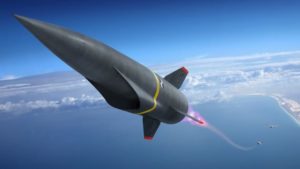The Defense Department on Monday disclosed a bilateral prototyping effort underway with Norway to explore advanced ramjet technologies useful for developing hypersonic missiles.
DoD and the Norwegian Ministry of Defence announced an intent to continue the Tactical High-speed Offensive Ramjet for Extended Range (THOR-ER) Allied Prototyping Initiative (API) under the Directorate for Advanced Capabilities within the Office of the Under Secretary of Defense for Research and Engineering Mike Griffin.

“The THOR-ER effort aims to cooperatively develop and integrate advancements in solid fuel ramjet technologies into full-size prototypes that are affordable, attain high-speeds, and achieve extended range, culminating in flight demonstrations in operationally relevant conditions,” DoD said in a press release.
The announcement said both the U.S. and Norway will consider potential co-production opportunities.
Griffin underscored this as “an important next step in advancing high-speed propulsion technologies with our Norwegian partners. It will drive fielding of the critical technologies needed to ensure U.S. and Allied military superiority in hypersonic systems.”
The THOR-ER effort is focused on a continuing collaborative research effort among the Navy’s Naval Air Warfare Center Weapons Division (NAWCWD) China Lake, the Norwegian Defence Research Establishment, and Norwegian aerospace and defense company Nammo.
NAWCWD’s land test range is at China Lake while it also has a sea test range at Point Mugu.
The Defense Department explained this API was launched in 2019 and “leverages new and existing frameworks for international cooperation in research and development.”
DoD spokesman Air Force Lt. Col. Robert Carver told Defense Daily in an email this effort started late last year and is currently planned to be finished by the end of 2024.
DoD said both countries are funding THOR-ER but declined to elaborate on amounts of the split.
“We are not disclosing the amounts at this time, but both governments have made equitable contributions to support the program,” Carver said.
The purpose of the API is to help the U.S. and its closest allied co-develop prototypes to bolster military superiority, rapidly co-developing “high-impact, game-changing, large-scale operational prototypes and to explore opportunities to energize the industrial bases within the U.S. and its closest Allies,” DoD said in the announcement.
“The THOR-ER development incorporates the results of long term R&D on missile and rocket technology in Norway. In my opinion this merger of U.S. and Norwegian R&D efforts and engineering skills strengthens alliance innovation, in addition it represents an opportunity for closer defence industrial base cooperation,” Morten Tiller, Norwegian National Armaments Director, said in a statement.
The initiative will “provide a game changing capability for our Armed Forces” and “it also brings bilateral cooperation to a whole new level,” Tiller added.
Nammo CEO and President Morten Brandtzæg argued his company’s involvement in THOR-ER “allows us to bring together the best of U.S. and Norwegian propulsion technology through the framework of a bilateral U.S.-Norwegian partnership, and this fits perfectly with our long term ambitions.”
The Defense Department noted work is occurring via a Navy organization, but did not disclose program-specific implications for THOR-ER development.
“While the individual services are working on hypersonics development, the department, through the Office of the Under Secretary of Defense for Research and Engineering, is providing overall guidance on the development of this technology…The THOR-ER effort aims to cooperatively develop and integrate advancements in solid fuel ramjet technologies into full-size prototypes that are affordable, attain high-speeds, fit on a variety of Navy or Air Force aircraft and achieve extended range, culminating in flight demonstrations in operationally relevant conditions,” Carver said.
Last month, Griffin said the department is planning billions of dollars of investment in components of hypersonic weapons, particularly entry-vehicle aeroshells, once it begins full production (Defense Daily, March 4).
The Navy is developing a new Common Hypersonic Glide Body (C-HGB) while the Army will oversee production. The Navy plans to buy a common missile stack rocket booster to lift the glide body to the edge of space, with the two parts together making an all-up round set to be used by the Army and Navy.
The Air Force plans to use the same glide body but a different launching system.
Later last month, the Pentagon finished a successful flight test for the C-HGB (Defense Daily, March 20).